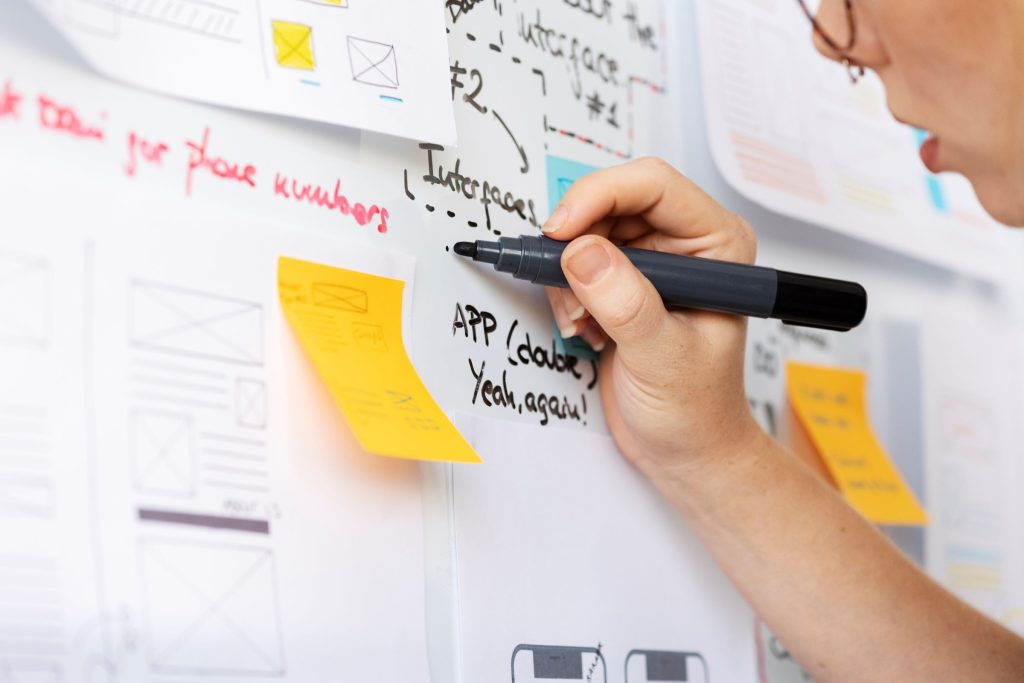Agilität ist die Fähigkeit, sich schnell an Veränderungen anzupassen. Agiles Arbeiten steht bei immer mehr Unternehmen auf der Agenda. Mitarbeitende wie auch Führungskräfte sollen entsprechend fit im agilen Arbeiten sein. Dazu gehört neben Techniken für die individuelle Arbeitsweise auch der Bereich Meetings und Workshops. Wie Arbeitsalltag, Meetings und Workshops agil(er) werden und welche Vorteile das für dich und dein Team bringt, das verraten wir dir in diesem Artikel.
Agiles Arbeiten weckt Bilder von bunten Post-its und jungen Start-ups mit Kicker? Ja, agiles Arbeiten ist hip und Teil von New Work. Aber so neu ist es gar nicht mehr. Mittlerweile sind agiles Denken und agile Konzepte schon in viele Arbeitsbereiche eingesickert. Also keine Panik! Bestimmt arbeitest auch du schon ab und an agil, ohne dir dessen bewusst zu sein. Zeit, das zu ändern!

Definition und Vorteile des agilen Arbeitens
Aber was genau versteckt sich hinter diesem Begriff? Definieren können wir Agilität als die Fähigkeit, sich schnell an Veränderungen anzupassen. Agiles Arbeiten umfasst eine Vielzahl an Methoden und Techniken. Den Grundstein aller agilen Methoden bildet das agile Manifest. Es wurde im Jahr 2001 von 17 Softwareentwicklern im Silicon Valley verfasst. Auf diesem Manifest basiert auch die Unterscheidung in agile Werte, Prinzipien, Techniken und Methoden. Komplette agile Methoden sind zum Beispiel Scrum oder Design Thinking. Agile Techniken sind hingegen kleinteiliger. Beispiele für solche Techniken sind das Modell der Personas oder das Format der Dailys. Agile Methoden bilden den Rahmen. Agile Techniken sind die konkreten Verfahren zur Umsetzung und diese stehen hier und in unseren beiden E-Trainings zum Thema im Mittelpunkt.
Aber agil(er) zu arbeiten bedeutet in den meisten Unternehmen erst einmal eine Umstellung und damit Mehraufwand. Wozu also das Ganze? Denken wir zurück an die Definition. Agil arbeiten ermöglicht, sich schnell an Veränderungen anzupassen, also schnell zu agieren. Und das ist in unserer schnelllebigen Zeit ein echter Wettbewerbsvorteil! Agilität ermöglicht es, früher, schneller und situationsbezogener zu agieren. Ein weiterer Vorteil agiler Methoden und Techniken: Mit ihrer Hilfe lassen sich Kreativität, Planbarkeit und Teammoral verbessern. Außerdem helfen sie, Risiken zu reduzieren, letztlich die Qualität zu steigern und den Produktwert zu optimieren.
Charakteristika des agilen Arbeitens: Was macht agiles Arbeiten agil?
Wichtige Grundprinzipien und Werte des agilen Arbeitens sind zum Beispiel die folgenden fünf Aspekte:
- Offenheit gegenüber Neuem und die Bereitschaft, Wissen zu teilen und sich auszutauschen.
- Commitment, also das Gefühl der Selbstverpflichtung und Identifikation mit anderen Teammitgliedern, dem Unternehmen und einem gemeinsamen Ziel.
- Die nötige Konzentration, um alle Energie und Aufmerksamkeit auf die EINE Aufgabe oder den EINEN Meilenstein zu richten, an der oder dem man gerade arbeitet.
- Mut, Neues auszuprobieren und Risiken einzugehen. Wichtig ist, anschließend konstruktiv mit Fehlern umzugehen.
- Vertrauen und Respekt, sowohl gegenüber Teammitgliedern und Führungskräften als auch gegenüber Kundinnen und Kunden.
Neben einem solchen agilen Mindset ist ein agiles Team eine wesentliche Voraussetzung für agiles Arbeiten. Klassischerweise sind agile Teams kleine, kollaborative Einheiten. Alle Mitglieder sind auf Schnelligkeit und Flexibilität ausgerichtet. Sie teilen sich gleichermaßen die Verantwortung und tragen so alle zum Erfolg bei. Dabei helfen regelmäßige Treffen, ein ständiger Austausch und iterative Prozesse, also ein ständiger Kreislauf aus Feedbackschleifen und Verbesserungen. Technische Unterstützung dafür bieten zum Beispiel ein (Social) Intranet, Kollaborationstools und Messenger-Dienste. Gerade beim Intranet stehen Funktionalität und klare Strukturen im Vordergrund. Schließlich sollen Informationen möglichst effizient ausgetauscht werden, und zwar unabhängig von Zeitzonen und teils gruppenspezifisch. Wesentliche Nutzungsoptionen eines Intranets sind daher:
- teils offene, teils geschlossene Gruppen
- die Option, über Vorschläge oder Möglichkeiten abzustimmen und dies auch übersichtlich darzustellen
- die Möglichkeit, andere Teammitglieder zu markieren und ihnen Aufgaben zuzuweisen oder direkt Fragen zu stellen
- die Option, Push-Benachrichtigungen zu aktivieren
- Filter- und Suchfunktionen direkt im Tool

Agiles Zeitmanagement
Agile Techniken können auch dabei helfen, Projekte und Aufgaben genauer zu planen und umzusetzen. Ein Beispiel ist Planning Poker, ein Teilbereich von Scrum: Planning Poker ist nützlich, um Aufwände besser abschätzen zu können – und zwar gemeinsam im Team. Dazu schätzt jedes Teammitglied anonym den Aufwand für ein Projekt oder eine Aufgabe und notiert die Zeit auf einem Zettel. Anschließend werden die Zahlen gesammelt und im Team gemeinsam ausgewertet, um einen realistischen Richtwert zu finden. Planning Poker eignet sich besonders für Projekte mit vielen unbekannten Variablen. Zugleich trägt es zum Teambuilding bei.
Auf individueller Ebene hilft eine weitere Technik im Arbeitsalltag: das sogenannte Timeboxing. Timeboxing bedeutet, vorab feste Zeitfenster für potenziell offene Aufgaben einplanen – und sich dann auch an diese Grenzen zu halten. Ein simpler Kalendereintrag kann dabei helfen. So erhält die Aufgabe einen klaren Rahmen. Am besten funktioniert Timeboxing, wenn es bereits im Voraus geplant und mit anderen Aufgaben sowie festen Terminen abgestimmt wird.

Task Boards – ein Herzstück des agilen Arbeitens
Auf die Planung folgt die Umsetzung: Im agilen Arbeiten kommen dabei häufig Task Boards zum Einsatz. Sie geben einen Überblick über aktuelle Aufgaben, indem sie diese visualisieren. Auf einen Blick wird klar: Welche Aufgaben gibt es? Wer ist zuständig? Bis wann sollten sie erledigt sein? Und vor allem: In welcher Phase der Bearbeitung befinden sich die einzelnen Aufgaben? In der Regel haben die Boards sechs oder vier Spalten. Dort werden Post-its mit Aufgaben entweder händisch oder (noch besser) virtuell angeheftet. Für den Anfang genügt das minimalistische Modell mit vier Spalten: Backlog, To-do, Doing und Done:
- Im Backlog sind die Aufgaben, die irgendwann anstehen, für die es aber noch keine feste Deadline oder kein verantwortliches Teammitglied gibt.
- In die Spalte To-do wandern alle Aufgaben, die als Nächstes anstehen.
- In Doing landen alle Aufgaben, die bereits bearbeitet werden. Hier wird auch kommentiert, wenn noch auf eine Reaktion oder ein Feedback gewartet wird. Das beschleunigt den Prozess und hilft, Abhängigkeiten zu verdeutlichen.
- In die letzte Spalte, Done, kommen alle Aufgaben, die erledigt und bereit zur finalen Prüfung sind. Das kann nach dem Vier-Augen-Prinzip durch einen Kollegen oder eine Kollegin oder durch die Team- bzw. Projektleitung erfolgen.
Entscheidend ist, auf allen Kärtchen direkt die jeweiligen Ansprechpartner:innen und eine Deadline einzutragen UND transparent zu sein: Sinn und Zweck ist schließlich, dass alle Teammitglieder auf dem gleichen Wissensstand bleiben. Zudem wird so deutlich, wo es noch Hindernisse gibt oder zusätzliche Unterstützung benötigt wird. Aus einer reinen Übersicht entsteht so eine aktive Zusammenarbeit im geordneten Fluss.
Agile Fehlerkultur und regelmäßige, agile Meetings
„Aus Fehlern lernen wir“ – diese Weisheit gab es lange vor agilen Frameworks. Aber was bedeutet eine agile Fehlerkultur? Und: Wie gehen Fehler nicht im Arbeitsalltag unter? Generell ist es dafür wichtig, offen zu kommunizieren und sich über Fehler und Missverständnisse auszutauschen, um sie künftig zu vermeiden. Strukturiert kann das zum Beispiel in Form von „Lessons Learned“-Meetings geschehen. Lessons Learned oder auf Deutsch: Gelernte Lektionen sind Meetings, die nach Abschluss eines Projektes stattfinden. Idealerweise organisiert die Projektleitung oder der Hauptverantwortliche das Meeting. Teilnehmen sollten alle Beteiligten. Folgende Fragen können als Leitfaden dienen:
- Was ist in diesem Projekt gut gelaufen?
- Was hat noch nicht so gut geklappt?
- Was nehmen wir daraus fürs nächste Mal mit? Was wollen wir beibehalten, was wollen wir nicht mehr tun und was möchten wir neu ausprobieren?
Nach jeder Frage haben alle die Möglichkeit, zu antworten, und alle Antworten werden als Stichpunkte zu der jeweiligen Frage gesammelt, zusammengefasst und protokolliert – und anschließend für alle einsehbar abgelegt. Eine weitere agile Meeting-Form sind „Fail Fridays“. Sie können wöchentlich oder monatlich, typischerweise am Freitag stattfinden. Im Mittelpunkt stehen dabei typische Fehler, verbreitete Probleme und Stolperfallen. Indem Mitarbeitenden dafür ein geschützter Raum zur Verfügung gestellt wird, können Fehler so bewusst gemacht, korrigiert und künftig vermieden werden.
Interne Meetings dienen in erster Linie regelmäßigen Status-Updates und Verbesserungen. Der Klassiker ist das Daily, auch Stand-up genannt. Es findet täglich und normalerweise im Stehen statt. So soll es möglichst kurz und effizient gehalten werden. Für das Daily sind die folgenden Fragen eine gute Leitlinie:
- Was ist gestern passiert?
- Was ist heute geplant?
- Welche Herausforderungen gibt es aktuell?
Parallel zum Meeting lässt sich auch wunderbar direkt das Task Board erweitern. So sind alle Beteiligten auf dem gleichen Stand und stimmen sich auf den Tag und die Aufgaben ein.
Eine allgemein wichtige Voraussetzung für agile Zusammenarbeit – und Zusammenarbeit überhaupt! – ist stets eine klar geregelte Kommunikation in Form von fest geplanten Meetings UND spontanen Gesprächen. Schnelle Absprachen lassen sich auch gut und unkompliziert über reine Chat-Programme abwickeln. Ein Stück weit bleibt das immer Geschmackssache. Wichtig ist, bereits vorhandene Tools effizient zu nutzen. Und auch neue Tools vorzuschlagen, die nützlich sein können. Das heißt: Augen und Ohren offenhalten!
Anlassbezogene, agile Workshops
Workshops gehören nicht zum Tagesgeschäft und wollen gerade deshalb gut geplant und zeitlich geschickt getaktet sein. Speziell Großgruppen-Workshops. Wie der Name vermuten lässt, zeichnen sich diese durch eine Vielzahl an Teilnehmenden aus. Das erfordert geeignete Räumlichkeiten und ausreichend Zeit. Beispiele für agile Workshops sind Lightning Talks oder Barcamps, auch bekannt als Unkonferenz, Ad-hoc-Nicht-Konferenz oder Open Space.
Lightning Talks sind eine Reihe von Kurzvorträgen von jeweils fünf bis zehn Minuten. Je nach Anzahl der Vorträge kann so ein Workshop dann insgesamt 30 bis 90 Minuten dauern. Das Besondere an den kurzen Vorträgen ist, dass die präsentierten Inhalte noch nicht abgeschlossen sind. So bieten der Workshop und das Feedback der Zuhörenden die Möglichkeit für Anpassungen und Veränderungen. Zugleich werden die Zuhörerinnen und Zuhörer mit ins Boot geholt und können sich über eine Vielzahl von Themen informieren. Barcamps hingegen dauern in der Regel deutlich länger – mindestens einen halben, eher einen ganzen Tag. Sie sind vergleichbar mit einer Art „offener“ Tagung. Vortragsinhalte, Referent:innen und Ergebnisse entstehen erst im Zusammenwirken aller Beteiligten. Dennoch gibt es ein Motto oder einen Titel, der den Auftakt bildet. Weitere wesentliche Bausteine eines Barcamps oder Open Space sind:
- Vorstellungsrunde zur Themensammlung
- Einteilen und Zusammenlegen von Themen in 45-minütige Sessions
- Einplanen von 15-minütigen Pausen
- Zeitfenster klar markieren und einhalten
- Ergebnisse sammeln und grafisch aufbereiten
- Ableiten eines Handlungsplans inklusive der Aufgaben und Verantwortlichen
Entscheidend für den Erfolg agiler Workshops ist immer auch das Timing. Idealerweise sollte keiner der Beteiligten gerade in der heißesten Phase des Jahres stecken: Das gilt für den Verkauf ebenso wie für die Produktion oder die Buchhaltung.
Kundenzentrierung – ein wesentlicher Wert im agilen Arbeiten
Verschiedene agile Techniken ermöglichen ein stärker kundenzentriertes Denken. Ein Beispiel dafür sind Personas. Personas sollen typischen Kundinnen und Kunden ein Gesicht geben. Dafür erhalten die fiktiven Personas einen Namen, ein Alter, einen Beruf, Familienstand und eine Wohnsituation sowie Hobbys. Insgesamt dürfen es ruhig drei bis sechs Personas werden. Anschließend schlüpft das Team in die Schuhe dieser Personas und fragt sich: Wie sieht das Produkt oder die Dienstleistung aus Sicht dieser Persona aus? Wie beurteilt sie die Vor- und Nachteile? Was wünscht sie sich zusätzlich?
Eine weitere Technik sind die User Stories. Sie beziehen sich immer auf ein Szenario und ganz konkret auf das Produkt oder die Dienstleistung. Die Anforderungen, die Kund:innen an das Produkt haben, finden dabei auf einer Karteikarte Platz. Die drei wesentlichen Informationen dabei sind Wert, Nutzer:in und Funktion. Außerdem nie aus dem Auge verlieren darf man die „echten“ Kundinnen, ihr Feedback und ihre Erfahrungen. Was gefällt ihnen? Was weniger? Welche Missverständnisse kommen vor und wie können sie ausgeräumt werden? All das hilft, besser (weil kundenzentrierter) zu entwerfen und zu produzieren.
Effizient agil arbeiten – allein und im Team
Agilität ist die Fähigkeit, sich schnell an Veränderungen anzupassen. Agile Mitarbeitende halten deshalb immer Augen und Ohren offen für Neues und trauen sich zu experimentieren. Ein funktionierendes Team, ein agiles Mindset und regelmäßiger Austausch sind die Basis, um kontinuierlich besser zu werden. Geeignete Techniken zur Visualisierung von Aufgaben, zum besseren Zeitmanagement und zur zielgerichteten Kommunikation runden das agile Arbeiten ab.
Mehr über agiles Arbeiten und darüber, welche Techniken sich wie in deinen Arbeitsalltag und die Meeting-Kultur in deinem Unternehmen integrieren lassen, erfährst du in unseren beiden E-Trainings zum agilen Arbeiten:
- Agile Tool-Box für den Arbeitsalltag
- Agile Tool-Box für Workshops und Meetings

